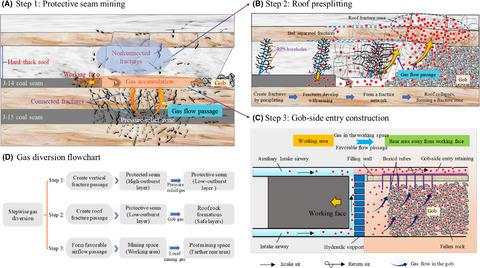当前位置:
X-MOL 学术
›
Energy Sci. Eng.
›
论文详情
Our official English website, www.x-mol.net, welcomes your feedback! (Note: you will need to create a separate account there.)
A safe mining approach for deep outburst coal seam groups with hard‐thick sandstone roof: Stepwise risk control based on gas diversion and extraction
Energy Science & Engineering ( IF 3.8 ) Pub Date : 2020-05-25 , DOI: 10.1002/ese3.714 Tong Liu 1, 2 , Baiquan Lin 1, 2 , Wu Xiao 3 , Ting Liu 1, 2 , Wei Yang 1, 2 , Zheng Wang 1, 2 , Ruigao Zhang 4
Energy Science & Engineering ( IF 3.8 ) Pub Date : 2020-05-25 , DOI: 10.1002/ese3.714 Tong Liu 1, 2 , Baiquan Lin 1, 2 , Wu Xiao 3 , Ting Liu 1, 2 , Wei Yang 1, 2 , Zheng Wang 1, 2 , Ruigao Zhang 4
Affiliation

|
Protective seam mining is the preferred method for gas control and safe mining in high‐outburst coal seam groups. However, a hard‐thick sandstone roof (HTSR) triggers new gas problems when it covers directly above the first‐mined protective coal seam. To solve these problems, a typical case study in No. 12 Coal Mine was conducted. The simulation results indicate that the HTSR greatly prevents the plastic deformation of the upper roof formations without affecting the expansive deformation in the underlying protected seams. The pressure‐relief gas in protected seams will flow into the protective seam without continuing to migrate to roof strata, thereby turning the protective seam into a new high‐risk area. Therefore, roof presplitting (RPS) technology was proposed to effectively break the HTSR, create roof fracture passages, and divert the gob gas of the protective seam upward. Meanwhile, gob‐side entry construction (GSEC) was conducted to enhance gas discharge in the protective seam by adopting rapid filling, roof cutting, and active supporting technologies. Through the upper protective seam mining, RPS, and GSEC, gas migration passages were constructed step‐by‐step to divert the gas from high‐risk areas to low‐risk areas. As a key first step, gas diversion not only optimized the distribution of gas sources but also significantly reduced gas hazards. Source‐by‐source extraction was then performed to effectively control the high‐concentration gas in the newly formed gas source, further eliminating the mining risk. By applying the stepwise risk control method combined with gas diversion and extraction, the safe production was successfully achieved with excellent outburst prevention effects, and the gas extraction rate was significantly improved to more than 66%. This practice could be used for deep high‐gassy or high‐outburst coal seam group mining.
中文翻译:

深厚煤层顶板突出煤层的安全开采方法:基于瓦斯抽采的逐步风险控制
在高突煤层组中,保护性煤层开采是瓦斯控制和安全开采的首选方法。但是,厚实的砂岩顶板(HTSR)覆盖在首次开采的保护性煤层正上方时会引发新的瓦斯问题。为了解决这些问题,在第十二煤矿进行了一个典型的案例研究。仿真结果表明,HTSR极大地防止了上部顶板地层的塑性变形,而不会影响下面的保护煤层的膨胀变形。保护煤层中的减压气体将流入保护煤层中,而不会继续迁移到屋顶地层,从而将保护煤层变成一个新的高风险区域。因此,提出了屋顶预裂(RPS)技术,以有效打破HTSR,创建屋顶裂缝通道,并向上转移保护层的采空区瓦斯。同时,通过采用快速充填,顶板切割和主动支护技术,进行了采空区进入施工(GSEC),以增强保护层中的瓦斯排放。通过上部保护性煤层开采,RPS和GSEC,逐步建立了天然气运移通道,以将天然气从高风险地区转移到低风险地区。作为关键的第一步,气体转移不仅优化了气体源的分布,而且还大大减少了气体危害。然后进行了逐源提取,以有效控制新形成的气源中的高浓度气体,从而进一步消除了开采风险。通过将逐步风险控制方法与气体转移和提取相结合,成功实现安全生产,防突效果好,瓦斯抽采率明显提高到66%以上。这种做法可用于深部高瓦斯或高突出煤层群开采。
更新日期:2020-05-25
中文翻译:

深厚煤层顶板突出煤层的安全开采方法:基于瓦斯抽采的逐步风险控制
在高突煤层组中,保护性煤层开采是瓦斯控制和安全开采的首选方法。但是,厚实的砂岩顶板(HTSR)覆盖在首次开采的保护性煤层正上方时会引发新的瓦斯问题。为了解决这些问题,在第十二煤矿进行了一个典型的案例研究。仿真结果表明,HTSR极大地防止了上部顶板地层的塑性变形,而不会影响下面的保护煤层的膨胀变形。保护煤层中的减压气体将流入保护煤层中,而不会继续迁移到屋顶地层,从而将保护煤层变成一个新的高风险区域。因此,提出了屋顶预裂(RPS)技术,以有效打破HTSR,创建屋顶裂缝通道,并向上转移保护层的采空区瓦斯。同时,通过采用快速充填,顶板切割和主动支护技术,进行了采空区进入施工(GSEC),以增强保护层中的瓦斯排放。通过上部保护性煤层开采,RPS和GSEC,逐步建立了天然气运移通道,以将天然气从高风险地区转移到低风险地区。作为关键的第一步,气体转移不仅优化了气体源的分布,而且还大大减少了气体危害。然后进行了逐源提取,以有效控制新形成的气源中的高浓度气体,从而进一步消除了开采风险。通过将逐步风险控制方法与气体转移和提取相结合,成功实现安全生产,防突效果好,瓦斯抽采率明显提高到66%以上。这种做法可用于深部高瓦斯或高突出煤层群开采。



























 京公网安备 11010802027423号
京公网安备 11010802027423号